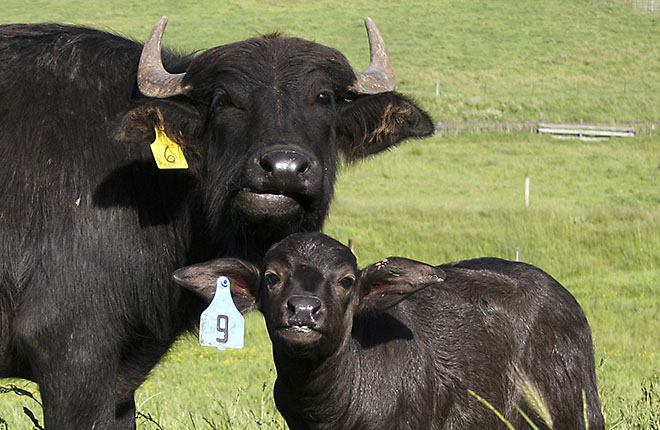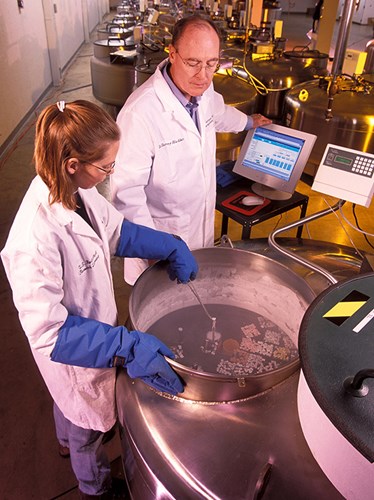Saving the Animals
The third in our series on the vital contributions of the ARS collections that conserve our genetic wealth. See Germplasm Collection Series under Additional Information.
|
|
There is no larger assembly of preserved genetic material from animals that provide food and fiber than that in the National Animal Germplasm Collection. Located in Fort Collins, Colorado, and composed mostly of cryogenically frozen sperm and embryos, the program includes nearly a million samples from 26 species.
The germplasm collection includes common domesticated species such as pigs, chickens, cattle, sheep, and farmed aquatic species like trout and catfish, and also less common domesticated species like bison, elk, and even yaks. Bison, in particular, are gaining popularity as livestock in the United States, with about 400,000 now being raised for meat. “There may not be a strong bison breed association right this minute keeping track of pedigrees, but storing the bison’s genetic diversity before any genetic bottlenecks develop is well worth doing,” says geneticist Harvey Blackburn, who leads the Agricultural Research Service’s (ARS) National Animal Germplasm Program (NAGP).
ARS’s animal germplasm collection is currently helping to pry open a genetic bottleneck in the Holstein dairy cow breed, which has had a decline in fertility and genetic diversity. All Holstein A.I. sires (providers of semen for artificial insemination) trace to just three bulls born in the 1960s, and the pedigrees of those three trace back to two bulls in the 1880s. At least two other lineages from the 1880s existed as late as the 1960s. NAGP’s reputation for preserving genetic diversity and making the materials publicly available allowed these lines to be evaluated for future use by researchers and industry. NAGP acquired these samples by brokering donations of frozen semen from both lines.
Since there is no way of predicting which genes will become important in the future, NAGP collects samples from across a given breed’s genetic diversity. In some cases, retiring producers have donated their collections; other times, active breeders will allow ARS scientists to collect and store samples. “Today, using pedigree evaluation and genetic molecular analysis, we are identifying specific gaps among breed collections and actively searching to fill them,” Blackburn says.
For breeds like the Holstein and Hereford, this means maintaining samples dating from the 1950s, when artificial insemination became available to the beef and dairy industries. Using such samples, researchers can study how the genetics of a breed have changed.
According to Blackburn, the ability to trace a breed’s genetics back through time recently proved especially valuable for one breed of cattle. A breed association wanted to test the offspring of an important bull from the 1980s for the presence of a lethal genetic mutation that had recently been showing up and needed to be eliminated from the population. The National Animal Germplasm Collection was the only source of a documented sample of this bull’s DNA. A single $22 DNA test cleared this bull and all of his 29,000 progeny, saving the industry the $638,000 needed to test each individual offspring.
NAGP also preserves the genes of heritage breeds such as the Gloucestershire Old Spots and the Large Black. These pig breeds, known for their docile nature and excellent abilities as foragers, originated in Britain and became popular here around 1900. To broaden their genetic diversity in this country, the animal germplasm collection recently worked with the North Carolina-based Livestock Conservancy to import semen from Britain for both U.S. breeders and the collection.
“I was surprised to learn that the British version of the Livestock Conservancy views the United States as a source of genetic diversity for their heritage breeds, and that they were pleased to know ARS had stored semen samples from American breeders, showing preservation works on a global scale,” Blackburn says.
One species Blackburn would like to see added to the collection is the water buffalo. “People in the United States have started raising the Italian water buffalo for milk production,” Blackburn says. This animal’s highest value product is true mozzarella di bufala (buffalo mozzarella). The United States imports around 100,000 pounds of buffalo mozzarella annually, and it is sold to restaurants and cheese shops for about $30 a pound. A home-grown source would be a valuable industry.
“Our mission is to build a germplasm collection that is at least as diverse as our existing livestock populations, as a safeguard. You never know when a disaster like the foot-and-mouth disease outbreak that hit Britain in 2001 could decimate the gene pool in a domestic livestock species,” says Blackburn. “And dead is dead-and-gone if there isn’t a backup in the freezer.”—By J. Kim Kaplan, Agricultural Research Service Information Staff.
“Saving the Animals” was published in the March 2016 issue of AgResearch Magazine.
Key Facts
- ARS’s germplasm collections preserve critical genetic resources.
- The animal germplasm collection includes common domesticated species.
- Heritage breeds are also conserved in the collection.
- New species are being considered for inclusion.
Full Story










